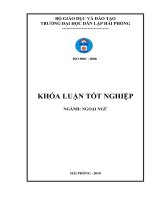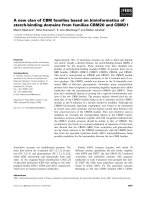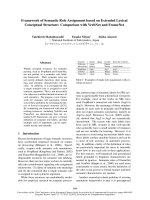Agricultural development based on application of biological high techs in China and lessons and suggestions for Vietnam
Bạn đang xem bản rút gọn của tài liệu. Xem và tải ngay bản đầy đủ của tài liệu tại đây (152.88 KB, 8 trang )
46
Agricultural development based on application of biological high techs…
AGRICULTURAL DEVELOPMENT BASED ON APPLICATION
OF BIOLOGICAL HIGH TECHS IN CHINA
AND LESSONS AND SUGGESTIONS FOR VIETNAM
Ass. Prof. Dr. Le Tat Khuong, MSc. Ta The Hung, MSc. Tran Anh Tuan
Institute for Regional Studies and Development, MOST
Abstract:
During more than two decades of application of policies for bio-technological development,
China has used and exploited successfully achievements of high techs in this new scientific
field and China has become one of the leading countries in fields of development of biotechnologies. These achievements are fruits of policies applied by the Chinese Government for
development of high techs based agriculture including the improvement of research system as
well as institutional mechanisms to encourage the development of bio-technologies for
commercialization ends. It is possible to see the development policies for high techs based
agriculture in China is close to the one which are being formed and developed in Vietnam.
Experience in organization, administration and coordination between ministries/branches as
well as involvement of enterprises in China are good lessons for forming, propagating and
developing bio-technologies in Vietnam in the coming time.
Keywords: High techs based agriculture; Bio-technologies; Policies for bio-technological
development.
1. Introduction
During the early reform periods (1979 - 1984), Chinese agricultural production
was extended and gained impressive achievements for productivity and crop
volume. The important factors deciding the success of Chinese agriculture
came from institutional changes, extensive investment and application of
intensive cultivation and S&T progresses [6]. Since 1984, however, the annual
growth rate of China lowered to 3 - 4% in comparison to 7% of the previous
years. The slow-down of agricultural growth of China in general or the one of
crop plants in particular showed that the Chinese agriculture would face huge
challenges if still being based on traditional technologies and available
resources such as cultivating lands and low labor to meet domestic increasing
demands of foods. The application of bio-technologies was considered as one
of the main solutions defined by the Chinese Government to develop a modern
agriculture.
The objectives of bio-technological development were well-indicated in
numerous policies for agricultural development of China. Starting from
concepts of applied research, China had defined the objectives of bio-
JSTPM Vol 1, No 4, 2012
47
technological development for food security, sustainable agricultural
development, increased incomes for farmers, reduced use of insecticides,
environment protection, human health and higher prices of Chinese agricultural
products on international markets [1, 2]. A global view of Chinese objectives
of bio-technological development shows that China is realizing the objectives
of agricultural modernization and upgrading of bio-technological R&D system
to international standards.
In order to achieve the above objectives, the Chinese Government implemented
development programs of high techs based agriculture in bio-technological
sector including reforms of research system, institutional changes and incentive
mechanisms for bio-technological development for commercialization ends [2].
Investment budgets of China in field of bio-technologies for plants and animals
has doubled for every 3-4 years during the last decade [8]. Through programs
of application of bio-technologies for agriculture development, the cultivation
area of bio-technologies based plants in China comes up to 3.9 million hectares
by 2011 which made China the 6-th ranked position in the world in this field
[5].
Because of similar geographical conditions, socio-economic particularities and
production practice between China and Vietnam, the experiences of about 30
years of agricultural development based on high techs of China surely would
be useful for Vietnam.
2. Roles of the Chinese Government in agricultural development based on
high techs
Financial sources for agricultural research and development organizations and
individuals mainly were provided by the Chinese Government. Private
financial sources for research were minor. Strategies for bio-technological
development, key research programs and policies for bio security
administration were set up by line ministries such as Ministry of Agriculture
(MOA), Ministry of Science-Technology (MOST), National Development and
Reform Committee (NDRC), Ministry of Health (MOH) and some other
concerned ministries. MOA takes the overall hosting responsibilities and
coordinates with other ministries to set up strategies for bio-technological R&D
programs, to define research programs and topics and objectives of research
projects, and concrete administration works for every stage. When research
institutes finished their research for genetically modified (GM) varieties the
National Bio Safety Committee (NBC) of MOA would issue license for field
tests. Finally, NBC provided environment safety certificates and then
permission for mass production. MOH is competent to provide food safety
certificates.
48
Agricultural development based on application of biological high techs…
At national level, Ministry of Agriculture, Chinese Academy of Sciences
(CAS) and Ministry of Education (MOE) are mainly in charge for agricultural
bio-technological R&D activities. Under management of MOA there are three
large research institutes which are Chinese Academy of Agricultural Sciences
(CAAS), Chinese Academy of Tropical Agriculture (CATA) and Chinese
Aquatic-Fishing Institute (CAFi). CAAS has 37 member research institutes of
which 12 research institutes, 2 key laboratories and 5 ministerial laboratories
carry out research programs for application of bio-technologies in agricultural
production. CAFi and CATA also set up their laboratories and research
programs for bio-technological research where every research institutes has
one key laboratory.
In addition, some non-MOA research institutes have their own biotechnological research programs for agricultural development. Among them 7
research institutes and 4 national key laboratories are from the Chinese
Academy of Sciences, some research institutes are from Chinese Academy of
Forestry (CAFo) and some universities of MOE. In 2001 there were 7 national
key laboratories, which were built up in 7 leading universities of China, for
agricultural bio-technological research and other agricultural problems related
to fundamental research in bio-technological fields.
At provincial level there are also R&D programs for agricultural biotechnologies and they were implemented similarly to the ones of national level.
Accordingly, every province has an agricultural science institute and, at least,
an agricultural university. Every agricultural science institute and agricultural
university has 1 or 2 research institutes or laboratories for agricultural biotechnologies. Financial funds for research activities of local research institutes
and universities are provided from local sources (key research and investment
projects) or State budgets (research projects) [7].
3. Roles of enterprises in high tech agricultural development in China
A series of research facilities in field of application of bio-technologies for
agricultural development were set up by the Chinese Government. The
cooperation between State owned research institutes and enterprises contributes
to push up high tech agricultural development for commodity production. For
example, Bio-technology Institute cooperates with Pioneer Company for
research of NM maize, Ricetech cooperates with Research Center of Crossed
Rices for research of GM rice, Delta and Pineland cooperate with CAAS for
research of bio safety management for Bt-cotton, Monsanto cooperates with
Syngenta for GM varieties of plants.
In fact enterprises contribute an important role for market objectives and
commercialization of important plants of China where there are three notable
sectors. First, seed producing industries have implemented commercial
JSTPM Vol 1, No 4, 2012
49
liberation of seed production which was based on market reforms of seed
production sector since 1990. Seed producing companies have their own
integrated production system in provincial and district level. Gaps between
research and practical production get shortened thanks to results of cooperation
between research institutes and seed producing companies or to enhanced
research capacities of seed producing companies.
Second, links between research institutes and markets have passed changes.
Some research institutes and even some individual researchers set up researchproduction companies to commercialize of high tech applied products. In this
type of companies, science-technical human resources come from scientists
which are working in research institutes. However, these companies operate on
basis of market demands. Actually some companies developed and participate
in securities markets. For example, BWK () was set
up through cooperation between Beijing University and Institute of
Development Biology and Genetics of CAS, Bio-technology Institute of CAS
and Beijing Agriculture-Forestry Institute. The above said cooperation form
between universities and research institutes was approved by MOST and
actually BWK is considered as national center for molecular biology of plants
in China [3].
Third, public-private partnership (PPP) activities are increasingly extended in
field of bio-technologies. The typical example is the case of Monsanto which
developed PPP links in field of GM seed production in China. Monsanto
together with Delta and Pineland starts their activities in Ha Bac Province since
1997 and then developed a JV company with a seed producing company of the
province known as Jidai JV Company. Similar JV companies were developed
with seed producing companies of An Hui and Son Dong Provinces.
4. Organization and management of high tech agricultural development in
China
Various ministries such as MOA, MOST, NDRC, MOE and other concerned
ministries are assigned of duties to set up research strategies, research
orientations and to decide research budgets. The same structure is implemented
at provincial level where provincial Departments of Science-Technology are in
charge of global management of S&T programs of provinces.
At national level, a council of experts from MOA and MOST sets up R&D
plans for agricultural bio-technologies for middle-term plans (5 years) and
long-term plans. Plans include the set up of R&D and regulations for
implementation of laws and policies. MOA is in charge of guiding,
coordinating and assessing R&D plans and large State invested projects
(MOST used to be charge of them). Ministry of Environment Protection (MEP)
is in charge of negotiating and implementing Bio Safety Protocol China had
50
Agricultural development based on application of biological high techs…
ratified in 2005. MOST and NDRC set up 4 large programs for development of
bio-technologies and high techs including “863 Plan”, “973 Plan”, “Special
Funds for GM plants” and “Key Science-Technology Programs”. “863 Plan” is
the development plan of high techs which was set up since 1986 to give
financial supports to applied research and fundamental research to develop
high techs in China including bio-technologies as one of the 7 priority
technological sectors.
National Key Science-Technology Program is a large program initiated since
1990. This program was put under hosting management of MOST and NDRC
to enhance equipment and infrastructure investment for development of high
techs. Similarly to “863 Plan”, “973 Plan” was initiated since 1997 and
implemented since 1998 to support fundamental scientific research (life
sciences and bio-technologies are priorities for supports from this program).
In China, NDRC is in charge to approve budgets of various terms: annual, five
years and long-term allocated for ministries. NDRC assigns Ministry of
Finance (MOF) to allocate funds to ministries and CAS. NDRC has
Department of High Techs (DHI) which is in charge also for bio-technologies.
DHI has various services in charge of concrete fields of high techs.
Agricultural Service, particularly its Division of Agricultural Bio-technologies,
together with MOST, controls Key Science-Technology Programs (KSTP)
including a large program for agricultural bio-technologies. In 2001, NDRC set
up Service of Industrialization to push up commercialization and to extend
applications of agricultural bio-technologies in and out of agricultural fields
through a large program entitled “High Techs Applied Industrialization
Program”.
MOA with its Science-Technology Department and Education Department are
in charge to control bio-technological programs in research systems of the
Ministry and to coordinate R&D programs at national and local level. Research
activities of research non-MOA controlled institutes, as rules, are independent
from R&D activities of MOA. Also, the control by MOA of research activities
of provincial research institutes, in practice, is limited.
Before, MOA gets involved into research programs of agricultural biotechnologies through processes of setting up of frameworks for master plans
for research and development of bio-technologies (e.g. five year plans, longterm plans and R&D laws) and implementation of policies for biotechnologies. However, MOST in directly in charge of the total activities in
field of bio-technologies. There was the only fund for agricultural science
training which was set up in 1990 was under management of MOA but the
fund volume was very minor compared to the ones controlled by MOST and
NDRC. Similarly to Vietnam, in China there were disputes about who, MOA
or MOST, is most suitable to control agricultural research programs in general
JSTPM Vol 1, No 4, 2012
51
and agricultural bio-technologies in particular. However, actually MOA was
chosen to be in charge of management of research programs.
On basis of guidelines by NDRC, MOST and MOA, development plans of
provinces and consultancies of other functional institutions, Provincial
Departments of Science-Technology set up a global strategy for research and
development of bio-technologies through five year plans and long-term plans
and decision of provincial budget allocations for research units. Provincial
Departments of Science-Technology are also competent to issue guidelines,
management and assessment of effectiveness of R&D plans, projects and use
of funds at local level.
2010 year was the final year of implementation of “the XI-th Five year plan of
development of bio-technologies” of China. Though China had developed
successfully GM cotton plants (70% of cotton cultivating land of China) [9],
other plants are not fully commercialized. China does not yet export high techs
applied plants abroad. China does not have large companies in field of biotechnologies. Almost all activities of research and development of biotechnologies remain within research institutes/universities [4]. Actually China
prepares a draft of “the XII-th Five year plan of development of biotechnologies” with the some focused priorities, namely focused technological
transfer from research institutes/universities to leading bio-technological
companies, financial supports for setting up bio-technological companies and
incentive measures for foreign or private investment to set up research
institutes and joint research programs, establishment of Government level
transaction systems to support local products applied with bio-technologies, 50
% reduction of taxes for bio-technology applied R&D activities at all the
administrative levels, 15% reduction of income tax for bio-technological
companies listed as high techs based companies.
5. Conclusion
During about 39 years of implementing policies for development of biotechnologies China has maximized the effective application of achievement of
high techs in this new fields of sciences and then become one of the world’s
leading nations in this field. Experiences from this development process in
China show that, in order to secure the effectiveness and to mitigate risks in
applying science-technology achievements in practical production, it is
necessary, first, to set up a unified organizational mechanism from central level
to local level. At central level, NDRC, MOA and MOST were assigned to host
and to coordinate activities with concerned ministries to set up research and
development strategies for bio-technologies, to identify research programs, to
approve and to assess research results. Similarly, for provincial level, the works
52
Agricultural development based on application of biological high techs…
are assigned to Provincial Planning and Development Committee and
Provincial Department of Science-Technology.
Procedures to set up development policies for bio-technologies need to provide
participation chances to many groups of actors including scientists, government
agencies, multinational companies, food processing enterprises, trading
organizations, farmer organizations, consumers and NGOs. In this case, the
issued policies would fit the context of the country and international
regulations.
The implementation of socialization of R&D activities for high techs in field of
bio-technologies can be conducted through incentive mechanisms which would
let research institutes and researchers set up companies for direct application of
bio-technologies in production process and then shorten the gaps between
research and practice. It is necessary also to push up the diversified
development of PPP forms, e.g. setting up of JV companies including FDI
enterprises, for application of high techs in field of bio-technologies. They
would contribute important part to realize the market objectives and
commercialization of high techs applied products.
It is also possible to note that high techs agricultural development policies in
China are close to the ones actually applied for the field of bio-technologies
which are being formed and developed in Vietnam. Experiences in
organization, management and coordination between ministries/branches as
well as the involvement of enterprises are good lessons for forming,
propagating and developing bio-technologies in close future.
High techs agricultural development in general and development of biotechnologies in particular were implemented in China and the process is highly
diversified. Lessons of success and limitation taken from this process of China
are precious for setting up policies and mechanisms to push up the high techs
agricultural development in effective manner in Vietnam./.
REFERENCES
1.
Ministry of Science and Technology. (1990) Biotechnology Development Policy. China
S&T Press. Beijing.
2.
Ministry of Science and Technology. (2000) Biotechnology Outline.
3.
US. China Economic and Security Review Commission. (2009) Research report on
Chinese High-tech industries.
4.
USDA. (2011) China-Peoples Republic of Biotechnology - GE Plants and Animals
Annual 2010.
5.
USDA. (2012) China-Peoples Republic of Agricultural Biotechnology Annual 2012.
JSTPM Vol 1, No 4, 2012
53
6.
Huang. J., Lin. J.Y và Rozelle. S. (2000) What will make Chinese agriculture more
productive? Working paper No. 56, Stanford Institute on for Economic Policy Research.
Stanford University.
7.
Huang. J., Wang. Q và Keeley. J. (2001) Agricultural biotechnology policy processes in
China.
8.
Huang. J. K., Hu. R., Rozelle. S and Pray. C. (2005) Insect-resistant GM Rice in Farmer
Fields: Assessing Productivity and Health Effects in China. Science, Vol. 308 No. 5722:
688-690.
9.
Huang. J and Yang. J. (2011) China’s agricultural biotechnology regulations. Export and
import consideration.









